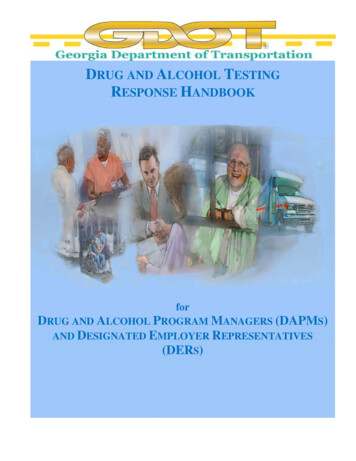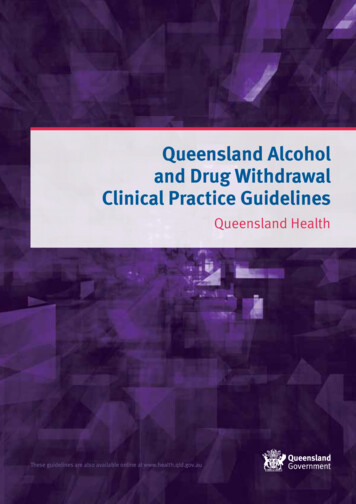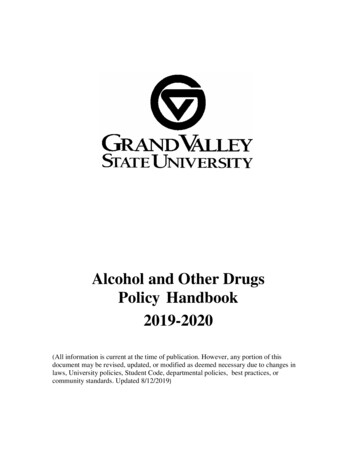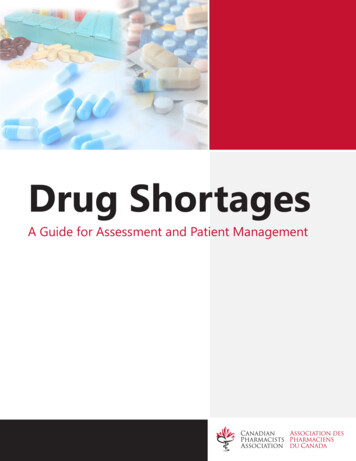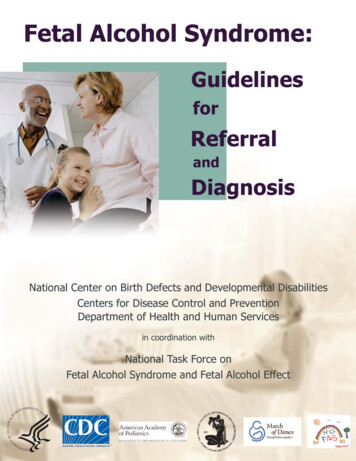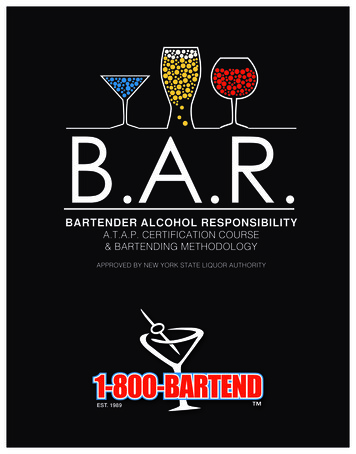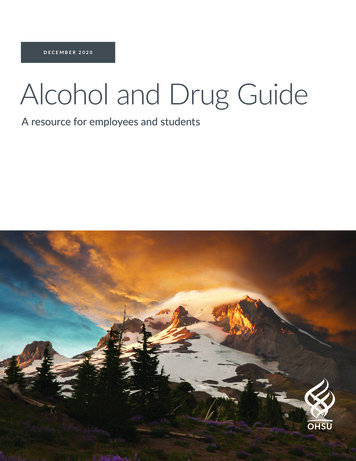
Transcription
DECEMBER 2020Alcohol and Drug GuideA resource for employees and students
ContentsAt OHSU, we are committed to a drug- and alcohol-free place ofStandards of Conduct 3especially in difficult times. This guide provides a number ofOHSU Employee Policies 5and family who may be struggling with drug or alcohol dependencyMarijuana legalization in Oregon 6to reach out, report a concern, share resources or seek supportstudy and work. We also care about each member of the community,support and recovery resources for you, your colleagues, friendsor abuse. If you’re concerned about someone, we encourage youyourself. It is important to know that treatments are available andOHSU Student Policies 7can be very effective.Violations and Sanctions 9OHSU is built on a foundation of integrity and commitment toHealth Risks 12Prevention and Recovery Resources 15our values. Yes, we abide by numerous laws, regulations, policiesand professional standards. But we seek to go beyond that, to holdourselves to a higher standard.This becomes clear with our institutional commitment to creatingand maintaining a drug- and alcohol-free environment. Thisguide outlines OHSU’s policies on drug and alcohol use, sanctionsfor violating federal, state and OHSU policies and the health risksassociated with alcohol and drug use.This guide also serves as a reminder of our expectations aroundthe behavior and conduct of our employees, faculty, students andvolunteers. First and foremost, coming to work or school under theinfluence of a substance is unacceptable. In addition to the legal andethical implications of substance possession or use, being underthe influence puts others at risk. That is in direct opposition to ourvalues of respecting this institution and each other. The safety andsecurity of all our members is paramount. Again, please use theresources we highlight in this document if you or someone youknow needs support.2
Standardsof ConductThe OHSU Policy Manual contains alcohol and drug related policiesOHSU is based on a culture of ethics,OHSU members is as follows:integrity, transparency and safety. ThatOHSU-wide policiesfor employees and students. The primary policy that applies to allincludes a commitment to maintaining aServing of Alcoholdrug-free institution. The OHSU CodePolicy No. 07-90-025of Conduct outlines expectations andresponsibilities. All members of the OHSUGeneral rule No use without approvalcommunity—employees, students andNo alcohol shall be served or consumed (1) on OHSU owned orvolunteers—have to behave in accordancewith these principles.controlled property, whether at an OHSU sponsored event or not,or (2) at an OHSU sponsored event, held on premises not owned orcontrolled by OHSU, unless approved by the division or departmenthead (or equivalent) and responsible Unit Leader of the sponsoringgroup. An event held on premises not owned or controlled by OHSUWe perform our duties and protectothers in the OHSU community by usingsound safety practices, including comingto OHSU free from the influence ofalcohol or any illegal drugs. The unlawfulmanufacture, distribution, dispersal,possession or use of illicit drugs byuniversity students or employees in theworkplace is prohibited.shall not be considered an OHSU sponsored event if no institutionalfunds or resources are used and attendance is not required byOHSU management.RequirementsExcept for events at the President’s residence or events approvedby the Provost, no event shall be approved under section 1(A) foruse of alcohol, unless: (1) It is sponsored by a unit or division ofOHSU or by an organization or group which is recognized andassociated with OHSU through its programs of education, research,patient care or community service; and (2) The sponsoring groupabides by and observes the OHSU Alcohol Use Risk Control Plandescribed below, which Plan shall automatically apply to any eventapproved under Section 1(A); and (3) Applicable Oregon LiquorControl Commission permits or licenses have been procured orwill be procured prior to the final approval of the event. (a) Eventsat which attendees are required to pay for alcohol, either directlyor indirectly (e.g., there is a charge for the event which helps coverbeverage costs) will require the sponsoring organization to obtaina license from the Oregon Liquor Control Commission. One day orspecial event licenses are available. (b) Events for which there is nocharge, either directly or indirectly, for beverages will not requirethe sponsoring organization to obtain a license from the OregonLiquor Control Commission.3
Alcohol Use Risk Control PlanPublic Safety personnelWhere alcohol is to be served, the following rules andFor events on OHSU-owned or controlled property,guidelines must be observed:the sponsoring group shall complete an electronic No alcohol may be served to or by anyone not of legalnotification on the Protocol and Events intranet pagedrinking age. No alcohol may be served to anyone who is visiblyintoxicated or any OHSU employee who the serverknows, or has reason to believe, has not completedtheir normal work schedule. Non-alcoholic beverages and food must be availablethroughout the event. All servers (vendors or others) who will be servingalcohol at the approved event must, prior to serving,be aware of and agree to abide by all requirements ofthe alcohol use risk control plan and other applicableOHSU policies. Alternative transportation options must be availablefor anyone who has been served alcohol. Sponsorsshall see that information about such options is madeavailable to attendees at the event. The amount of time at which alcohol will beavailable should be limited to a reasonable timeframe and should cease at least 30 minutes prior toat least five (5) business days prior to the event. If theDirector of Public Safety determines that Public Safetypersonnel need to be on site or available, the sponsoringgroup shall be responsible to pay the cost of providingPublic Safety personnel for the event.Payment for alcoholExcept as the Provost or OHSU policy providesotherwise (see Policy No. 06-60-010), institutional fundsmay not be expended to purchase alcoholic beverages.SanctionsAs is true for violations of OHSU policies generally,failure to follow these policies may result indisciplinary action up to and including dismissal.Further, failure to abide by these requirements mayresult in confiscation of the misused substance or otherpenalties, including personal liability for the employeeinvolved for any fines, litigation or other costs involvedas a result of such failure.the conclusion of the event. Unless a meal, or theequivalent of a meal, is provided, serving should berestricted to ninety (90) minutes. OHSU employees attending OHSU sponsored functionsshall not consume alcohol unless they have fullycompleted their normal work schedule (see Policy No.03-30-095, prohibition on being under the influence). OHSU employees shall not act as servers at an event. Alcohol shall be served by an approved vendorchosen from a list of approved vendors maintainedby Protocol and Events or by a commercial hostingfacility licensed to serve alcohol when the event isheld at such facility. Sponsors must ensure that all applicable rules, laws,and other requirements, such as liquor licensingrequirements, are met.4
OHSUEmployee PoliciesDrug and Alcohol UsePolicy No. 03-30-095ProhibitionsNo person shall be under the influence of any unlawful drug, anyalcohol, or misused prescription drug while in the workplace, whileon duty, or while operating a vehicle or equipment owned or leasedby OHSU. An unlawful drug is any drug that is illegal under federal,state or local law. Employees suspected of being under the influencein violation of this prohibition may be required to submit to a drugor alcohol test in accordance with Policy No. 03-10-015.No person shall unlawfully use, possess, sell, manufacture,distribute or dispense alcoholic beverages or drugs on propertyowned or controlled by OHSU.SanctionsEmployees who violate this prohibition will be disciplined inaccordance with applicable bargaining agreements and applicableUniversity procedures. Actions include, but are not limitedto, required participation in a substance abuse assistance orrehabilitation program, oral or written reprimand, suspension ortermination and/or referral of the matter for prosecution.Reporting of convictionsEmployees must notify their supervisor, and by phone or in writingto the Vice President for Human Resources, of any criminal drugstatute conviction for a violation occurring in the workplace orin the course of their job duties within five days of the conviction.Additionally, any OHSU member shall report to the Director ofPublic Safety any criminal conviction (except a traffic offense)within 15 days of the conviction (Policy No. 03-10-011). Further, theUniversity is required by law to notify the appropriate governmentagency of such a conviction within ten days of receiving theconviction notice.Drug and Alcohol Testing (Employees)Policy No. 03-10-015PUBLIC SAFETY BACKGROUNDER5
Drug and alcohol free workplaceTo promote the health, safety and productivity ofemployees, and the health and safety of the individualswe serve, it is the policy of OHSU to provide a drug andalcohol free workplace. To support this goal, OHSUhas established a testing program consisting of pre- The employee to be screened shall be relieved oftheir duties, and arrangements shall be made fortesting and for transportation home as appropriate,following the test. Refusal to submit to the testor failure to report to the testing site is cause fordisciplinary action.employment testing of applicants for employment inspecified positions and “reasonable suspicion” testingany drug that is illegal under federal, state or local law.Marijuana legalizationin OregonReasonable suspicion drug and alcohol testingIn 2014, Oregon Measure 91 legalized theof employees who are suspected of being impaired bydrug or alcohol use while at work. An unlawful drug isAny employee may be required to submit to a drugor alcohol test if there is reasonable suspicion theemployee is under the influence of drugs or alcoholwhile at work. Reasonable suspicion testing of classifiedemployees is governed by the applicable collectivebargaining agreement.Behavior and physical signs indicating substance abuserecreational use of marijuana. OHSU’s practicesdid not change as a result of the measure. Asa recipient of federal funds, OHSU is requiredto comply with federal laws and regulationsregarding marijuana possession and use,including the Drug-Free Workplace Act of 1988.OHSU’s Drug and Alcohol Use policy continuesto prohibit being under the influence or inmay include but not be limited to:possession of any unlawful drug, misused Observed impairment of job performance;prescription drug or any alcohol while in the Abnormal conduct or erratic behavior; A serious workplace accident or number of minorworkplace accidents; Evidence of drug tampering in the employee’sworkplace; or Abnormal physical conditions including but notlimited to bloodshot eyes, slurred speech, lethargy ordrowsiness, lack of coordination and odor of alcoholon breath.Requirements If an employee’s behavior and/or physical conditioncause reasonable suspicion of substance abuse, asupervisor shall contact the department head andrequest that a drug or alcohol screen be performed. Thedepartment head may require the employee to submitworkplace, while on duty, or while operating avehicle or equipment owned or leased by OHSU.The policy has been updated to clarify that “anunlawful drug is any drug that is illegal underfederal, state or local law.”OHSU’s Drug and Alcohol Testing policyalso provides for pre-employment testing ofapplicants for specified positions and reasonablesuspicion testing of employees who are suspectedof being under the influence of unlawful drugsor alcohol while at work. The drug test panelfor both pre-employment and for-cause testingincludes THC, which remains illegal underfederal law. This policy was also updated toclarify that “an unlawful drug is any drug that isillegal under federal, state or local law.”to drug testing for reasonable suspicion. The suspiciousEmployees with a professional license shouldbehavior and/or physical condition shall be documentedkeep in mind that many professional licensingand placed in the employee’s personnel file.boards have their own requirements regardingdrug and alcohol use.6
OHSUStudent PoliciesConduct Relating to Students-Proscribed ConductPolicy No. 02-30-010No student shall engage in conduct proscribed by an applicableschool or program or by the University or its Board of Directors,including but not limited to the OHSU Code of Conduct. Engagingin proscribed conduct shall subject a student to sanctions rangingfrom oral or written reprimand to dismissal, according to writtenprocedures administered by the student’s school or program.Proscribed conduct related to alcohol and drug use: Illegal use, possession, manufacture, diversion, sale, dispensation,or distribution of drugs or controlled substances, includingbeing under the influence or impaired, on institutionally ownedor controlled property (absence of criminal penalties is notconsidered express authorization). Inciting others to engage in any of the conduct or to perform anyof the acts prohibited herein. Inciting means that advocacy ofproscribed conduct that calls on the person or persons addressedfor imminent action and, coupled with a reasonable apprehensionof imminent danger to the functions and purposes of theUniversity, including the safety of persons, and the protection ofits property.Specific Proscribed ConductWithout limiting the generality of the above, the following conductis proscribed by the University: Conviction of a felony, a class A misdemeanor or of a crimeinvolving moral turpitude (which shall include, but not be limitedto, sex or drug related crimes) while attending the University orprior thereto if the conviction was not disclosed (if the applicationprocess required disclosure) in applying to the University foradmittance;Reporting Proscribed Conduct Related to Drug and AlcoholViolationsSchool or program officials must report to Public Safety whenever astudent is either arrested or referred for disciplinary action for: Liquor Law Violations Drug Law ViolationsPUBLIC SAFETY BACKGROUNDER7
Student Drug and Alcohol Testing4.tampering or evidence that the student tamperedPolicy No. 02-01-003To promote the health and safety of all students andpatients in their care, OHSU has established a drugtesting program consisting of pre-matriculation testing,pre-clinical experience testing and “for cause” testingfor any student suspected of being under the influenceEvidence of student involvement with drugwith a previous drug test;5.Abnormal physical conditions including but notlimited to bloodshot eyes, slurred speech, lethargyor drowsiness, lack of coordination, and odor ofalcohol on breath.of lawful and/or unlawful drugs or alcohol during theirA failed test or refusal to take a test may result incourse of study.dismissal from the academic program in accordancePre-Matriculation TestingAll students accepted into educational programs withwith school or program policies or OHSU Policy No. 0230-010 Conduct Relating to Students-Proscribed Conductor other actions, including referral to an appropriatea clinical component shall be offered conditionaltreatment program.admission pending the results of a pre-matriculationStudent Suspension, Dismissal and Appealdrug test. Failure of a pre-matriculation drug testmay result in denial of admission into the academicprogram. Individual school policy shall dictate thetiming of such tests, ensuring at a minimum, studentsare tested before their initial clinical experience.Policy No. 02-30-050A sanction of suspension or dismissal shall be imposedonly after a hearing on the matter is conducted inaccordance with school policies and procedures andClinical and Safety Sensitive Placement Testingadvice from the OHSU Legal Department.Students participating in clinical or safety sensitiveIf a school or program has reasonable grounds to believeactivities shall be made aware that drug testing maythat a student presents a serious and imminent threat tobe required dependent upon individual placements.other persons or themselves, the student may be subjectStudents that are unable to pass testing for individualto interim suspension. Interim suspension may becomeclinical placements or safety sensitive activities may beeffective immediately without prior notice. Studentssubject to disciplinary action.facing interim suspension will receive a hearing and/or“For Cause” Drug and Alcohol Testingmedical evaluation as soon as is practicable.Behavior and Physical Conditions Giving Rise toReasonable SuspicionBehavioral and physical signs giving rise to reasonablesuspicion for testing may include but not be limited to:1.Observable phenomena, such as direct observationof drug use or possession and/or the physical signsand symptoms of being under the influence of adrug or alcohol;2.Abnormal conduct or erratic behavior;3.A serious accident or number of minor accidentsduring any experience in which the studentparticipates;8
Violations andSanctionsOHSU sanctionsIn addition to any penalties under federal and state law, employeesor students found to be in violation of OHSU policies may be subjectto disciplinary sanctions consistent with applicable provisionsof state and federal laws, regulations and policies (includingapplicable Oregon Administrative Rules, administrative rules, theOregon Health & Science University Code of Conduct, applicablecollective bargaining agreements and applicable OHSU policies).If imposed, sanctions will include appropriate action up to andincluding dismissal and/or termination of employment and referralfor prosecution and may require participation in an approved drugand/or alcohol abuse assistance or rehabilitation program.State of Oregon sanctionsAlcoholMinor in possession: Any attempt to purchase or acquire alcoholicbeverages by a person under 21 years is a violation (up to 1000fine). A minor is not in violation of, and immune from prosecutionfor, minor in possession if the person contacted emergencymedical services or a law enforcement agency in order to obtainmedical assistance for another person who was in need of medicalassistance due to alcohol consumption and the evidence of theviolation of this section was obtained as a result of the person’shaving contacted emergency medical services or a law enforcementagency; or the person was in need of medical assistance due toalcohol consumption and the evidence of the violation of thissection was obtained as a result of the person’s having sought orobtained the medical assistance.Providing liquor to a minor: Class A misdemeanor (up to one year injail and a fine, plus restitution and community service) Mandatoryminimums: First conviction: 500; second conviction: 1,000; thirdor subsequent conviction: 1,500 and 30 days.Driving under the Influence of Intoxicants: Driving a vehicle whileunder the influence of intoxicants is a class A misdemeanor with apenalty of up to one year in jail and a 10,000 fine and suspension orrevocation of driving privileges. For purposes of Motorist ImpliedConsent Laws, a person under 21 years of age with any amountof alcohol in the blood constitutes being under the influence ofintoxicating liquor.PUBLIC SAFETY BACKGROUNDER9
Illicit drugsIn Oregon, penalties for possession and distributionare determined by the controlled substance scheduleUnlawful Manufacture Adult (8 plants, 16 ounces solidproduct, 72 ounces liquid product, extract): Class Cfelony (up to 5 years in prison and up to 125,000 fine).upon which the drug appears. Examples from the drugUnlawful Manufacture under 21 years old: Class C felonyschedules appear below. (Note: Most drugs appear on(up to 5 years in prison and up to 125,000 fine).the same federal and state schedule.)Unlawful Possession under 21 years old (one ounce orSchedule I: Heroin, LSD, marijuana (federal law) peyote,less leaves, stems and flowers): Violation (Presumptivemescaline, psilocybin, methamphetamine (Oregon law)fine 650)Schedule II: Opium, cocaine, methamphetamineUnlawful Possession under 21 years old (1 ounce to 8(federal law), marijuana (Oregon law)ounces leaves, stems and flowers, less than 16 ouncesSchedule III: Amphetamine, depressants, PCPsolid product, less than 72 ounces liquid product):Class B misdemeanor (up to 6 months in jail and up toSchedule IV: Various prescription drugs 2,500 fine).Schedule V: Other less dangerous prescription drugsUnlawful Possession under 21 years old (8 ounces leaves,and small amounts of certain drugsstems and flowers, 16 ounces solid product, 72 ouncesMarijuanajail and up to 6,500 fine).Unlawful Delivery to minor by adult 21 : Class C felonyUnlawful Possession adult (1 ounce in public, 8 ounces(up to 5 years in prison and up to 125,000 fine plustwice the value of any resulting gain of property ormoney).Unlawful Delivery/Manufacture within 1000’ of a school(above no consideration homemade delivery allowance):Class A felony (up to 20 years in prison and up to 375,000 fine plus twice the value of any resulting gainof liquid product): Class A misdemeanor (up to 1 year inleaves, stems and flowers, 16 ounces solid product,72 ounces liquid product, 1 ounce extract): Up to 2xallowable amount - Violation (fine up to 1000), 2x upto 4x allowable amount - Class B misdemeanor (up to6 months in jail and up to 2,500 fine), 4x allowableamount - Class A misdemeanor (up to 1 year in jail andup to 6,500 fine).of property or money).Schedule I drugsUnlawful Delivery (above no consideration homemadeManufacture or distribution (except marijuana): Class Adelivery allowance): Class A misdemeanor (up to 1 yearin jail and up to 6,500 fine plus twice the value of anyfelony (up to 20 years in prison and up to 375,000 fineplus twice the value of any resulting gain of property orresulting gain of property or money).money).Unlawful Delivery not for consideration (non-homemadeUnlawful possession: Class B felony (up to 10 years inless than one ounce leaves, stems and flowers): Class Aviolation (up to 2,000 fine).Unlawful Delivery not for consideration (non-homemadeless than five grams leaves, stems and flowers): Violation(Presumptive fine 650).Unlawful Manufacture Adult (4 plants): Class Bmisdemeanor (up to 6 months in jail and up to 2,500fine)prison and up to 250,000 fine).Schedule II drugsManufacture or distribution: Class B felony (up to 10years in prison and up to 250,000 fine plus twice thevalue of any resulting gain of property or money).Unlawful possession: Class C felony (up to 5 years inprison and up to 125,000 fine).10
Schedule III drugsFederal sanctionsManufacture or distribution: Class C felony (up to fiveThe federal system establishes sanctions for possessionyears in prison and up to 125,000 fine plus twice theand distribution of controlled substances based on thevalue of any resulting gain of property or money).schedule of the drug and the amount involved. TheUnlawful possession: Class A misdemeanor (up to oneyear in jail and up to 6,500 fine).Schedule IV drugsManufacture or distribution: Class B misdemeanor (upto six months in jail and up to 2,500 fine plus twice thevalue of any resulting gain of property or money).Unlawful possession: Class C misdemeanor (up to 30days in jail and up to 1,250 fine).Schedule V drugsManufacture or distribution: Class C misdemeanor (30days jail and up to 1,250 fine plus twice the value ofany resulting gain of property or money).Unlawful possession: Violation ( 250 fine).It is unlawful for a person to manufacture or deliver aschedule I, II, or III controlled substance within 1,000feet of the real property comprising a public or privateelementary, vocational or secondary school attendedby minors (Class A felony, penalty of up to 20 years inprison and 375,000 fine).In addition, the court may order the defendant to paythe cost of prosecution, and the defendant’s vehiclestatutory sanctions for possession and distributionare also subject to the “Sentencing Guidelines forU.S. Courts,” though imposition of the guidelinesmay lead to higher offense levels and, thus, stricterpenalties than otherwise indicated. Courts mustmake adjustments in the offense level for victimrelated considerations, the defendant’s role in theoffense, multiple counts, obstruction and acceptanceof responsibility. Finally, the guidelines establishsentences for each offense based on the defendant’scriminal history. The range of federal penal sanctionsis: thirty years to life in prison (regardless of thedefendant’s criminal history) for the manufacture,distribution or trafficking of large amounts ofheroin, cocaine, PCP, methamphetamine, Schedule Iand II hallucinogens, marijuana, hashish, or any oftheir derivatives; zero to four months in prison forpossession of any Schedule III or IV drug if defendanthas lowest level of criminal history. Further, if seriousinjury or death results from the crime, minimums ofup to 10 years in prison (serious injury) and 20 yearsin prison (death), plus fines of up to 4 million may beadded. These penalties may be doubled for defendantswith past felony drug convictions. Finally, penalsanctions in the federal system are “real time,” withreductions in sentences only for good behavior.used in the crime may be forfeited to the state. Finally,the defendant may forfeit any property used in thecrime to the county in which the crime occurred.11
Health RisksThere are numerous health risks associated with alcohol abuse andillicit drug use. The substances covered in this guide include: Tobacco and nicotine Alcohol Cannabis (marijuana,hashish, hashish oil,tetrahydrocannabinol) Inhalants (nitrous oxide,amyl nitrite, butyl nitrite,chlorohydrocarbons,hydrocarbons) Cocaine (crack) Stimulants (amphetamines, Depressants (barbiturates,methaqualone, tranquilizers) Hallucinogens (PCP, LSD,mescaline, peyote, psilocybin) Narcotics (heroin, methadone,codeine, morphine,meperidine, opium) Designer drugs (analogsof fentanyl, analogs ofmeperidine, MDMA, ecstasy,analogs of PCP)methamphetamines, crank, ice) Anabolic steroidsTobacco and nicotineSmokers are more likely than nonsmokers to contract heart disease.Lung, larynx, esophageal, bladder, pancreatic, and kidney cancersalso strike smokers at increased rates. Thirty percent of cancerdeaths are linked to smoking. Chronic obstructive lung diseases,such as emphysema and chronic bronchitis, are 10 times morelikely to occur among smokers than among nonsmokers. Smokingduring pregnancy also poses risks, such as spontaneous abortion,pre-term birth, and low birth weights. Fetal and infant deathsare more likely to occur when the pregnant woman is a smoker.Nicotine is both psychologically and physically addictive.AlcoholLow doses significantly impair the judgment and coordinationneeded to operate vehicles. Small amounts can also lowerinhibitions. Moderate to high doses cause marked impairmentsin higher mental functions and loss of memory and the ability tolearn and remember information. High doses cause respiratorydepression and death. Long-term consumption, particularly whencombined with poor nutrition, can also lead to dependence andpermanent damage to vital organs such as the brain and the liver.If combined with other depressants of the central nervous system,much lower doses of alcohol will produce the effects just described.Mothers who drink alcohol during pregnancy may give birth toinfants with fetal alcohol syndrome. These infants have irreversiblephysical abnormalities and mental retardation.PUBLIC SAFETY BACKGROUNDER12
Cannabis (marijuana, hashish, hashish oil,tetrahydrocannabinol)Cocaine (crack)Cocaine stimulates the central nervous system. ItsPhysical effects of cannabis include increased heart rate,immediate effects include dilated pupils and elevatedbloodshot eyes, dry mouth and throat, and increasedblood pressure, heart rate, respiratory rate, and bodyappetite. Use of cannabis may impair or reduce short-temperature. Occasional use can cause nasal irritation;term memory and comprehension, alter sense of time,chronic use can ulcerate the mucous membrane of thereduce ability to perform tasks requiring concentrationnose. Crack or freebase rock is extremely addictive.and coordination, and impair driving ability. MotivationPhysical effects include dilated pupils, increased pulseand cognition may be altered, making the acquisitionrate, elevated blood pressure, and insomnia, loss ofof new information difficult. Marijuana, hashish, THC,appetite, tactile hallucinations, paranoia, and seizures.etc., can also produce paranoia and psychosis. Long-termThe use of cocaine can cause death by cardiac arrestuse may result in possible lung damage, reduced spermor respiratory failure. During pregnancy cocaine iscount and sperm motility and may affect ovulationfetotoxic. It causes indirect effects by its actions on thecycles. Cannabis can also be psychologically addictive.mother’s blood vessels and direct effects by crossing theChronic use of marijuana by males can reduce the levelsplacental barrier. Because of the wide spectrum of bothof testosterone. Marijuana freely crosses the placenta,kinds of effects on the unborn, the syndrome is not asleaving the developing brain susceptible to marijuanawell defined as fetal alcohol syndrome.substances. Even greater risk is associated with theconcomitant use of other fetotoxic drugs. Duringpregnancy the use of marijuana should be avoided.Inhalants (nitrous oxide, amyl nitrite, butyl nitrite,chlorohydrocarbons, hydrocarbons)Stimulants (amphetamines, methamphetamines,crank, ice)Stimulants cause increased heart and respiratory rates,elevated blood pressure, dilated pupi
Drug and Alcohol Use Policy No. 03-30-095 Prohibitions No person shall be under the influence of any unlawful drug, any alcohol, or misused prescription drug while in the workplace, while on duty, or while operating a vehicle or equipment owned or leased by OHSU. An unlawful drug is any drug

